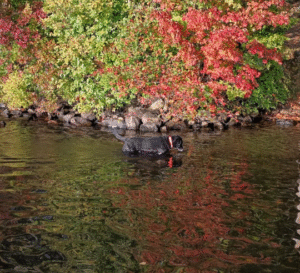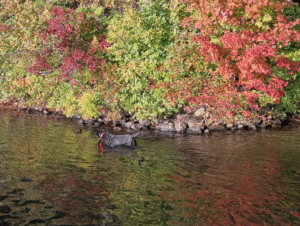FROGS

Green Frog
Scientific Name: Rana clamitans
Adult green frogs range from 2-4 inches in body length. Dorsolateral ridges, prominent, seam-like skin folds that run down the sides of the back, distinguish the green frog from the bullfrog, which entirely lacks them. Green frogs live wherever there is shallow fresh water - ponds, road-side ditches, lakes, swamps, streams and brooks. Green frogs breed in freshwater. Males call from and defend territories. The distinctive call sounds like a plucked banjo string, usually given as a single note, but sometimes repeated. The breeding season is from April to August. The female releases her eggs and the male simultaneously releases sperm which swim to the egg mass. A single egg clutch may consist of 1000 to 7000 eggs. Green frog tadpoles are olive green and iridescent creamy-white below. Tadpoles graze on algae and water plants. Males become mature at 1 year, females may mature in either 2 or 3 years. Green frogs will attempt to eat any mouth-sized animal they can capture, including insects, spiders, fish, crayfish, shrimp, frogs, tadpoles, small snakes, birds, snails.

American Bullfrog
Scientific Name: Rana
Catesbeiana The American Bullfrog is an aquatic frog and is a member of the Ranidae family. The bullfrog is the largest of the North American ranids, reaching a body length of 7.9 inches, and weighing up to 1.7 lb. Bullfrogs are generally varying shades of green or brown. The head is usually mostly green. The body varies from olive to brown, and may be darkly blotched or spotted. Breeding begins in late spring or early summer and fertilization is external in ranid frogs, meaning the female bullfrog deposits her eggs in the water and the male simultaneously releases sperm. Bullfrog Tadpole Eggs hatch in 3–5 days and takes a few months to metamorph from a tadpole into a bullfrog. The maximum lifespan is estimated at 8–10 years. The bullfrog, like many other ranid frogs, is an ambush predator. At a chosen site, the visually vigilant frog waits relatively motionless until prey appears and elicits its feeding behavior. The bullfrog’s usual diet consists of many invertebrates but have been known to prey on any animal it can overpower and stuff down its throat. This includes rodents, small turtles, snakes, frogs including bullfrogs, birds, and even a bat.

Gray Tree Frog
Scientific Name: Hyla versicolor
As the name Hyla versicolor implies, gray tree frogs are highly variable in color because of their ability to camouflage themselves from gray to green, depending on the object they are sitting on. They are relatively small compared to other North American frog species, typically attaining no more than 1.5 to 2 inches in length. Their skin has a lumpy texture to it, giving them a warty appearance. Hyla versicolor have bright yellow patches on the hind legs and are only visible while the frog is jumping. Males have black or gray throats, while the throat of the female is lighter. Tadpoles have a rounded body with a high, wide tail that can be colored red if predators are in the system. Metamorphosis can occur in as little as 2 months. Gray Tree Frogs inhabit a wide range, and can be found in most of the eastern half of the United States. Gray tree frogs are primarily arboreal, spending time in wooded areas, usually not far from a permanent water source. On rainy evenings they can often be found calling in or near shallow, temporary pools of water, and often in your swimming pool. They are nocturnal and insectivorous, consuming most any small arthropod they can catch. They will also eat algae if readily available. Mating occurs throughout the spring and summer months.They also will change colors, as in a light green to a gray, to match their habitat.

Spring Peeper
Scientific Name: Pseudacris crucifer
A Spring Peeper is a small chorus frog widespread throughout the eastern USA and Canada. The spring peeper is a small species, attaining an adult size between 0.75 inches and 1 inch long. They have a dark cross on their backs roughly in the shape of an "X", though sometimes the marking may be indistinct. The color variations of the Spring Peeper are mostly tan, brown, olive green, and gray. Females are lighter-colored, while males are slightly smaller and usually have dark throats. The spring peeper eats small arachnids and insects such as ants, and water bugs. Its predators include great diving beetle larvae (when in tadpole form), snakes, skunks, and larger frogs. Spring peepers that breed in northern areas breed from March to June when the warm rain starts. Spring Peepers typically lay around 900 eggs per clutch, but up to 1000 is possible. In very cold weather, they hibernate under logs and loose bark. Spring peepers are nocturnal frogs, and they are mostly heard but not seen. They are especially easy to hear due to their extremely loud mating call which gives them the name "peeper", but it is often hard to pinpoint the source of the sound, especially when many are peeping at once.
Turtles

Painted Turtle
Scientific Name: Chrysemys Picta
The Painted Turtle lives in ponds, lakes, marshes, and in slow-moving rivers that have soft, muddy bottoms. The maximum carapace size, or shell length, for painted turtles is 10 inches. The underside, or plastron, of the Painted turtle's shell has a beautiful design that (hence the name) looks like it is painted. The plastron can be solid yellow, mostly yellow with a pattern in the center, or may be a complicated pattern of yellow and red. There are yellow or red lines on the painted turtle's head, and limbs. The breeding season lasts from late spring to early summer. Painted turtles are amniotes, which requires females to nest on land. Painted turtle eggs hatch 72 to 80 days after they are laid. Once the young hatch and dig out of the nest, they are immediately independent. Painted turtles are most active from May to October in the Northeast. The painted turtle spends the majority of its time in the water, but it can often be seen lying in the sun on floating logs or on rocks by the shore. This behavior is called basking. Painted turtles bask because they cannot generate heat or regulate their own body temperature. Instead, they rely on heat from the sun to maintain their body temperature for them.

Snapping Turtle
Scientific Name: Chelydridae
Snapping turtles only live in fresh or brackish water. They prefer water bodies with muddy bottoms and abundant vegetation because concealment is easier. The snapping turtle normally has a shell length ranging from 8 -18 1/2"and has a tail nearly as long as the shell. The tail has saw-toothed keels on it. The shell ranges in color from dark brown to tan and can even be black in some individuals. Snapping turtles have characteristic tubercles on their necks and legs. Plastrons of snapping turtles are very small and leave much of the extremities exposed. Snapping turtle necks, legs, and tails have a yellowish color and the head is dark in color. Mating takes place from April to November. Interestingly, female snapping turtles sometimes store sperm for several years, allowing individuals to mate at any time of the year independent of female ovulation, and it also allows females to lay eggs every season without needing to mate. Snapping turtles are estimated to live up to 30 years. They feed on carrion, invertebrates, fish, birds, small mammals, amphibians, and a surprisingly large amount of aquatic vegetation.
Rodents

Muskrat
Scientific Name: Ondatra zibethicus
The muskrat is a medium-sized semi-aquatic rodent native to North America. The muskrat is found in wetlands and adapts to a wide range of climates and habitat. The muskrat's name comes from the two scent glands, which are found near its tail; they give off a strong "musky" odor, which the muskrat uses to mark its territory. Muskrats can swim under water for up to 15 minutes. Muskrats normally live in family groups consisting of a male and female pair and their young. Muskrats are most active at night or near dawn and dusk. They feed on cattails and other aquatic vegetation. Plant materials make up about 95 percent of their diets, but they also eat small animals such as freshwater mussels, frogs, crayfish, fish, and small turtles.









